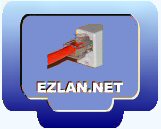|
EZLAN.NET
Copyright © 2001-2007
|
Hardware and Software Specifications, Examples, Links, and other info. are valid at the publishing time. In case it become invalid use the Internet Search. 1st Published, Dec. 2004 Over 6,500,000 Hits Site Wide in 2006 
How Do I Find my IP and MAC Numbers? What is an External, and Internal IPs. When using TCP/IP (The Network protocol that is used for both LAN and Internet), your presence on the Internet, and the internal identification of Computers is done via an IP Address (Number). There are two kinds of IP Numbers. 1. External Public address that is assigned by the Internet Service Provider (ISP) and it used for maintaining your traffic To and From the Internet. 2. Internal (or Private Local) IP number that is assigned locally to your computers for controlling local Traffic (LAN). Local IP number would usually look as 192.168.x.x, the X is a number from 0 Ė 255. The External Public IP can be. 1. Dynamic IP, your External IP (aka WAN IP) is assigned by the ISPís central servers and can occasionally change. Almost all Entry Level Internet accounts are Dynamic. 2. Static IP, your External IP (aka WAN IP) is assigned by the ISPís central servers at the beginning of your contract, and it would stay always the same. Static IP usually costs more and comes with a Business account. The External IP has to be set according to your contract (it is not a choice) , setting it to a Static IP while having a Dynamic Account will result in losing the Internet Connection If a single computer is connected directly to the Internet via a modem (could be Cable, DSL, Dialup, etc.), when it is logging into the Internet the computer would be assigned with External IP As an Example, my External IP today (as assigned to me by Time Warner Internet Cable Service) is 68.173.33.202, if I connect a single computer to my Cable Modem that would be the computerís IP. When you use a Cable/DSL Router (or a Wireless Cable/DSL Router) to share one Internet account among few computers, or just using a Router to protect a single computer. The computers would be assigned with a Private Local IP address. The roll of the Router is to Route (Mitigate) between your LAN (Private IPs) and the Internet (External IP). The Router has an Internet Side (WAN side) that it is connected to the modem and should be configured with the type of External IP as assigned by the ISP. Using a Router does not change the Status of your External IP. The Routerís WAN side IP has to be set according to your contract, setting it to a Static IP while having a Dynamic Account will result in losing the Internet Connection (Configuration instructions should be in the Router's manual).Once behind the Router, the computerís, or computersí IPs is not anymore the External IP, it becomes a private IP that can be assigned by the user as Static, or dynamic IP (consult your Routerís manual for the specific configuration). The private LAN setting to Static, or Dynamic, has nothing to do with the type of your Internet account. According to the ISP contract and your internal neede it can be. External Dynamic, with Static and dynamic on the LAN Side External Static, with Static and dynamic on the LAN Side. What ever you use for the Private IP is not reflected to the Internet. The Internet traffic comes and goes only by the External IP. If you want to be able to connect to your computers from the Internet, and you have an External Dynamic IP that changes in time look at option 3 here, http://www.ezlan.net/myip.html All the content of this page is the same for Wired, and Wireless computers. How do I find my local IP? The most common method is to use Windows command line ipconfig utility. This utility is available by default in Win98 and WinXP.Click on Start/Run and type cmd and press <Enter>, the DOS Window would come up. Type ipconfig/all and you Local IP would appear on the screen, in the line IP Address. Write it down type Exit and press <Enter> and you are Windows. Output example here: ipcfg Win98 has a GUI utility too, it is called Winipcfg, and it is available by Default.Click on Start/Run and type Winipcfg you would see on the screen a box with your IP NumberOutput example here at the middle of the page: ipcfgWinXP does not come with a GUI Utility, however the GUI utility that comes with Win2000 works in WINXP and it is a free Download from Microsoft. Download:WntIpcfg_setup.exeRun the setup file, the program would be installed in: C:\Program Files\Resource Kit Copy the file WNTIPCFG .EXE to C:\Windows Click on Start/Run type Wntipcfg and press <Enter>.Output example here at the middle of the page: ipcfgExternal IP? The most common way to get your External IP is to log to one of Sites that provides you feedback with your External IP in the Site's page. Example: whatismyip.com However my favorite method is to use the IP2 Utility. IP2 is an excellent small Free program that provides you with your Internal and External IPs. It is fast and even let you copy the IPs with one click for each. Download unzip it to a Directory of you choice (n othing to install), and Run it.Link to: IP2 Output example here at the middle of the page: ipcfg MAC Number? Every Network's Hardware Part has a unique ID number that is assigned by the manufacturer. It is Called MAC number. How can I find my Network Card ID (MAC number)? All the Utilities mentioned above (beside IP2) will provide you your NIC MAC number as well. Output example here: ipcfg
|